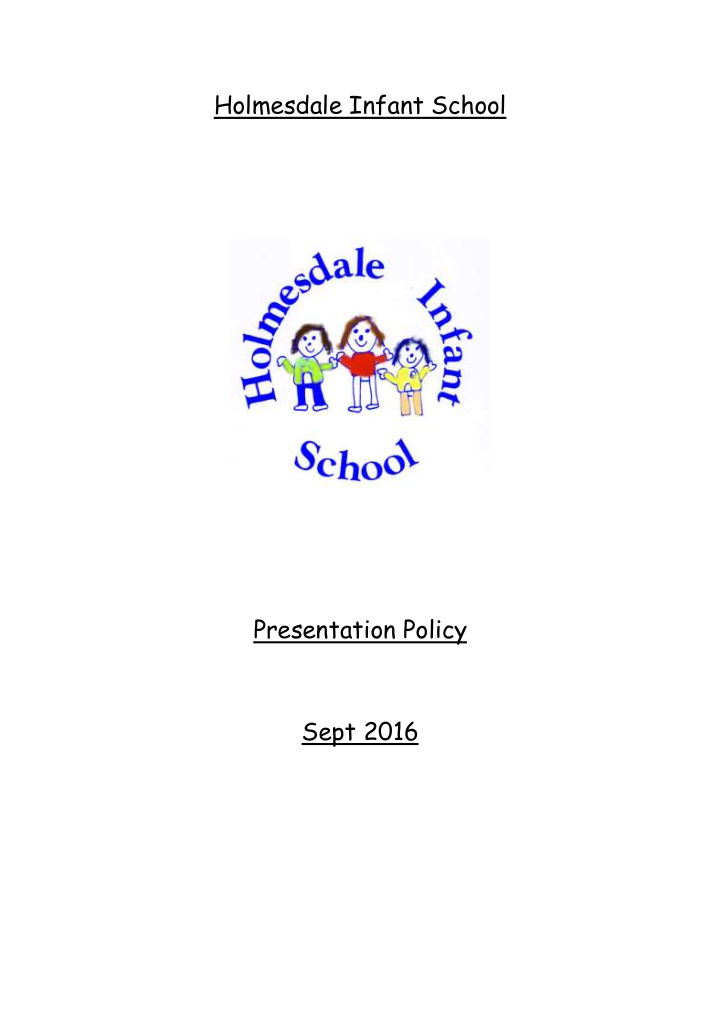



Holmesdale Infant School Presentation Policy Sept 2016
Aims To establish pride and high expectations in everything we do – both of ourselves and of the children. To create a clear and consistent set of guidelines for the presentation of children’s learning. Objectives To motivate each individual to present their work in the best possible way. To enable children to recognise that work is presented to a high standard. To ensure that each child know the standard of presentation that is expected of them. To secure an ‘I can do’ attitude and ethos of challenge, care, pride and attention to detail. Expected outcomes Children of all ages and abilities are expected to present their work to their highest possible standard, increasing their confidence and self-esteem. There is consistency across the school in terms of standard of presentation expected across the curriculum. There is accelerated progression in presentation of work, with higher expectations and better outcomes. Expectations for staff To create a shared ethos and culture of high expectations in presentation, in all subjects To support the children in supporting their work, encouraging re-drafts and not just accepting the first attempt To consistently model good presentation and handwriting through modelling, marking and display [including the modelling of making mistakes, re-drafting, correcting and improving work] To monitor standards of presentation, awarding progress and attainment and addressing continued poor presentation through support and intervention if necessary To monitor presentation in subject areas by work and book scrutiny and lesson observations To use lines to write on, wherever possible
To look after children’s books, treating them with respect and sticking in wo rk etc neatly, cut to size. To follow the agreed handwriting scheme, and teach children to do the same To address letter reversals and presentation errors immediately in feedback time [eg – ‘footballs’ for full stops, i instead of I, b and d reversals, sho rt rather than tall capital letters, doodling in the margin, scribbling out work, not using a ruler etc] To ensure that displays include a range of work by children of different abilities, shows the child’s first name, has a clear title and explanation tha t can be typed or handwritten in accordance with the school’s handwriting script and remains attractive Handwriting Teachers must follow the agreed policy for handwriting and follow the agreed letter formation. In modelled writing staff must make clear the capital letters, and make explicit reference to the fact that other letters are not joined onto these. Handwriting should be taught every day for the first term as well as in phonics and SPAG lessons. During handwriting sessions, teachers should support the children in their writing, giving immediate feedback and correction time for mistakes. Expectations for children into KS1 [These expectations are not for Reception children, until they are ready. However the consistent messages around presentation should be made clear as soon as children come into school] To use sharpened pencils to complete work, unless told by the teacher to use a pen To not use rubbers, mistakes should be crossed out with a single line To use the short date [eg 3/5/16] at the top of each piece of work To use a ruler to underline any titles or headings To make sure the book is the correct way up, and to not leave blank pages At the beginning of Year 1 I will start a new piece of work on a clean page. By the summer of Year 1 and into Year 2 I will start a new piece of work by drawing a line under the last piece of work and starting on a new line To make sure I will use a ruler to put one neat line through mistakes To write on the lines in my book and write next to the margin, if there is one To use a line guide if I am writing on a blank piece of paper
To write one digit in each square in my maths book To use a sharpened pencil unless my teacher tells me to use a handwriting pen. To not use felt tip pens or coloured pencils to write in my book, unless I am told to. To make any corrections neatly To not draw in any part of my book unless I am told to, including the margins and front and back covers To try my best to be proud of every piece of work I do
I will….. use sharpened pencils to complete work, unless told by the teacher to use a pen not use rubbers, mistakes should be crossed out with a single line use the short date [eg 3/5/16] at the top of each piece of work use a ruler to underline any titles or headings make sure the book is the correct way up, and to not leave blank pages At the beginning of Year 1 I will start a new piece of work on a clean page. By the summer of Year 1 and into Year 2 I will start a new piece of work by drawing a line under the last piece of work and starting on a new line make sure I will use a ruler to put one neat line through mistakes write on the lines in my book and write next to the margin, if there is one use a line guide if I am writing on a blank piece of paper write one digit in each square in my maths book use a sharpened pencil unless my teacher tells me to use a handwriting pen. To not use felt tip pens or coloured pencils to write in my book, unless I am told to. make any corrections neatly not draw in any part of my book unless I am told to, including the margins and front and back covers try my best to be proud of every piece of work I do
Recommend
More recommend